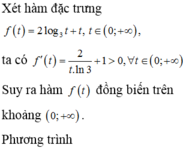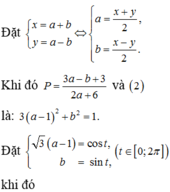Hãy nhập câu hỏi của bạn vào đây, nếu là tài khoản VIP, bạn sẽ được ưu tiên trả lời.

\(4=2^x+2^y\ge2\sqrt{2^{x+y}}\Rightarrow2^{x+y}\le4\Rightarrow x+y\le2\)
\(\Rightarrow xy\le1\)
\(P=4x^2y^2+2x^3+2y^3+10xy\)
\(P=4x^2y^2+10xy+2\left(x+y\right)\left[\left(x+y\right)^2-3xy\right]\)
\(P\le4x^2y^2+10xy+4\left(4-3xy\right)=4x^2y^2-2xy+16\)
Đặt \(xy=t\Rightarrow0< t\le1\)
Xét hàm \(f\left(t\right)=4t^2-2t+16\) trên \((0;1]\)
\(\Rightarrow...\)

\(\Leftrightarrow2y^3-6y^2+7y-3=-2x\sqrt{1-x}+2\sqrt{1-x}+\sqrt{1-x}\)
\(\Leftrightarrow2\left(y^3-3y^2+3y+1\right)+y-1=2\left(1-x\right)\sqrt{1-x}+\sqrt{1-x}\)
\(\Leftrightarrow2\left(y-1\right)^3+y-1=2\left(\sqrt{1-x}\right)^3+\sqrt{1-x}\) (1)
Xét hàm \(f\left(t\right)=2t^3+t\)
\(f'\left(t\right)=6t^2+1>0\Rightarrow f\left(t\right)\) đồng biến
Nên (1) tương đương: \(y-1=\sqrt{1-x}\Rightarrow y=1+\sqrt{1-x}\)
\(\Rightarrow P=x+2\sqrt{1-x}+2=-\left(1-x-2\sqrt{1-x}+1\right)+4=-\left(\sqrt{1-x}-1\right)^2+4\le4\)
⇒ P = x + 2 √ 1 − x + 2
= − ( 1 − x − 2 √ 1 − x + 1 ) + 4
= − ( √ 1 − x − 1 ) 2 + 4 ≤ 4
Cho xin một like đi các dân chơi à.


a. Đề bài em ghi sai thì phải
Vì:
\(x+y=2\left(\sqrt{x-3}+\sqrt{y-3}\right)\)
\(\Leftrightarrow\left(x-3-2\sqrt{x-3}+1\right)+\left(y-3-2\sqrt{y-3}+1\right)+4=0\)
\(\Leftrightarrow\left(\sqrt{x-3}-1\right)^2+\left(\sqrt{y-3}-1\right)^2+4=0\) (vô lý)
b.
Xét hàm \(f\left(x\right)=x^3+ax^2+bx+c\)
Hàm đã cho là hàm đa thức nên liên tục trên mọi khoảng trên R
Hàm bậc 3 nên có tối đa 3 nghiệm
\(f\left(-2\right)=-8+4a-2b+c>0\)
\(f\left(2\right)=8+4a+2b+c< 0\)
\(\Rightarrow f\left(-2\right).f\left(2\right)< 0\Rightarrow f\left(x\right)\) luôn có ít nhất 1 nghiệm thuộc (-2;2)
\(\lim\limits_{x\rightarrow+\infty}f\left(x\right)=x^3\left(1+\dfrac{a}{x}+\dfrac{b}{x^2}+\dfrac{c}{x^3}\right)=+\infty.\left(1+0+0+0\right)=+\infty\)
\(\Rightarrow\) Luôn tồn tại 1 số thực dương n đủ lớn sao cho \(f\left(n\right)>0\)
\(\Rightarrow f\left(2\right).f\left(n\right)< 0\Rightarrow f\left(x\right)\) luôn có ít nhất 1 nghiệm thuộc \(\left(2;n\right)\) hay \(\left(2;+\infty\right)\)
Tương tự \(\lim\limits_{x\rightarrow-\infty}f\left(x\right)=-\infty\Rightarrow f\left(-2\right).f\left(m\right)< 0\Rightarrow f\left(x\right)\) luôn có ít nhất 1 nghiệm thuộc \(\left(-\infty;-2\right)\)
\(\Rightarrow f\left(x\right)\) có đúng 3 nghiệm pb \(\Rightarrow\) hàm cắt Ox tại 3 điểm pb

Đặt \(x+y=t,t\in\left[-2;2\right]\)
Biến đổi được \(P=-2t^3+6t\)
Xét \(f\left(t\right)=-2t^3+6t\) trên \(\left[-2;2\right]\)
Lập bảng biến thiên
Ta có \(P_{Max}=4\) khi t=1
\(P_{Min}=-4\) khi t= -1

Bài này thì chia 2 vế của giả thiết cho z2 ta thu được:
\(\frac{x}{z}+2.\frac{x}{z}.\frac{y}{z}+\frac{y}{z}=4\Leftrightarrow a+2ab+b=4\)
(đặt \(a=\frac{x}{z};b=\frac{y}{z}\)).Mà ta có: \(4=a+2ab+b\le a+b+\frac{\left(a+b\right)^2}{2}\Rightarrow a+b\ge2\) Lại có:
\(P=\frac{\left(\frac{x}{z}+\frac{y}{z}\right)^2}{\left(\frac{x}{z}+\frac{y}{z}\right)^2+\left(\frac{x}{z}+\frac{y}{z}\right)}+\frac{3}{2}.\frac{1}{\left(\frac{x}{z}+\frac{y}{z}+1\right)^2}\) (chia lần lượt cả tử và mẫu của mỗi phân thức cho z2)
\(=\frac{\left(a+b\right)^2}{\left(a+b\right)^2+\left(a+b\right)}+\frac{3}{2\left(a+b+1\right)^2}\).. Tiếp tục đặt \(t=a+b\ge2\) thu được:
\(P=\frac{t}{\left(t+1\right)}+\frac{3}{2\left(t+1\right)^2}=\frac{2t\left(t+1\right)+3}{2\left(t+1\right)^2}\)\(=\frac{2t^2+2t+3}{2\left(t+1\right)^2}-\frac{5}{6}+\frac{5}{6}\)
\(=\frac{2\left(t-2\right)^2}{12\left(t+1\right)^2}+\frac{5}{6}\ge\frac{5}{6}\)
Vậy...
P/s: check xem em có tính sai chỗ nào không:v

Bạn xem lại đề nghen, đoạn thỏa mãn đó có vấn đề phải không nhỉ?

Bạn ơi có thể hướng dẫn chi tiết giúp mình không? cám ơn nhiều ạ

Do \(1\le x\le2\Rightarrow\left(x-1\right)\left(x-2\right)\le0\)
\(\Leftrightarrow x^2+2\le3x\)
Hoàn toàn tương tự ta có \(y^2+2\le3y\)
Do đó: \(P\ge\dfrac{x+2y}{3x+3y+3}+\dfrac{2x+y}{3x+3y+3}+\dfrac{1}{4\left(x+y-1\right)}\)
\(P\ge\dfrac{x+y}{x+y+1}+\dfrac{1}{4\left(x+y-1\right)}\)
Đặt \(a=x+y-1\Rightarrow1\le a\le3\)
\(\Rightarrow P\ge f\left(a\right)=\dfrac{a+1}{a+2}+\dfrac{1}{4a}\)
\(f'\left(a\right)=\dfrac{3a^2-4a-4}{4a^2\left(a+2\right)^2}=\dfrac{\left(a-2\right)\left(3a+2\right)}{4a^2\left(a+2\right)^2}=0\Rightarrow a=2\)
\(f\left(1\right)=\dfrac{11}{12}\) ; \(f\left(2\right)=\dfrac{7}{8}\) ; \(f\left(3\right)=\dfrac{53}{60}\)
\(\Rightarrow f\left(a\right)\ge\dfrac{7}{8}\Rightarrow P_{min}=\dfrac{7}{8}\) khi \(\left(x;y\right)=\left(1;2\right);\left(2;1\right)\)










\(\Leftrightarrow\left(x-1\right)^3+x-1=\left(\sqrt{1-y^2}\right)^3+\sqrt{1-y^2}\)
Xét \(f\left(t\right)=t^3+t\)
\(\Rightarrow f'\left(t\right)=3t^2+1>0\forall t\)
\(\Rightarrow\) f(t) đồng biến trên R nên f(t)=0 có nhiều nhất 1 nghiệm
\(f\left(x-1\right)=f\left(\sqrt{1-y^2}\right)\)\(\Rightarrow x-1=\sqrt{1-y^2}\)
\(P=\left(\sqrt{1-y^2}+1\right)^2+y^2+4\left(\sqrt{1-y^2}+1\right)-8y\)
\(=6+6\sqrt{1-y^2}-8y\)
\(P'=\dfrac{-6y}{\sqrt{1-y^2}}-8\), \(y\in\left(-1;1\right)\), \(P'=0\Leftrightarrow y=-0,8\left(tm\right)\)
Vẽ BBT, \(P_{max}=16\Leftrightarrow y=-0,8,x=1,6\)